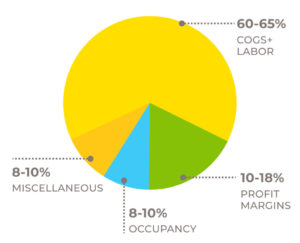Sign up for restaurant insights
Are you considering opening a new restaurant, adding a virtual restaurant, or pivoting your restaurant’s business strategy to adapt to the shifting restaurant industry? Make sure you take the time to build a restaurant business plan. Why?
- Business plans are like professional road maps — they literally lead the way to success
- They’re critical if you’re looking for investors and need to outline your restaurant’s current wins and future revenue potential
- They help you foresee challenges before they arise, so you can sidestep some catastrophes and be better prepared for the others
Some 26% of restaurants fail within a year of opening, and failure to plan is one of the primary reasons those restaurants close. Create a business plan, and you’re setting yourself up to be on the right side of that statistic.
Here’s how to do it.

What is a restaurant business plan?
Before you learn how to write a business plan, it’s crucial to understand what a business plan is — and what it isn’t.
The goal of a business plan is to create a guide that helps you navigate each stage of launching and running your business. That plan should also be comprehensive and articulate enough that a total stranger, for instance an investor, could read through it and easily understand your vision, your goals, and how you intend to turn your restaurant dream into a reality.
Business plans come in a variety of structures and they can be as short as a single page or long enough to bind into a booklet. You may want to start with a lean startup plan that focuses on a high-level take on your strategy, then follow up with a more detailed plan that elaborates on key points and offers investors more information.
In short, your business plan should communicate everything you have and plan to put into your restaurant to ensure ongoing success.
11 elements every restaurant business plan should include
Your restaurant and mission statement should be unique to your business and your vision, but that doesn’t mean you have to start completely from scratch. Crafted by industry experts and packed with insider knowledge, the Grubhub Restaurant Business Plan template is your step-by-step guide to whipping up a winning business strategy. Take a look at our editable business plan template to start planning your restaurant. However you write it, your finalized business plan should include seven key sections.
1. Executive summary
This is a brief summary of your company, why it’s something the community wants or needs, and why it will be successful. Many different types of restaurants speak to various demographics, and it’s important to know what kind of restaurant you want to run. Are you opening a quick-service deli focused on takeout sandwiches and ready-to-eat salads? Or are you going to be the first tapas restaurant in a city eager for more variety?
If you’re using your business plan to ask for financing, the SBA recommends including financial information and high-level growth plans in your executive summary, too. Your executive summary should include:
- Mission statement: A concise description of your restaurant’s purpose
- Proposed concept: The summary or outline of the restaurant idea
- Execution: How you plan to make this proposed concept work
- Potential costs: A brief overview of expected exprenses
- Anticipated ROI: How much the restaurant is expected to make
Think of your summary as your opportunity to capture your reader’s attention. Many investors will make a split-second decision based on the executive summary alone — if this section is all they’re going to read, make every word count.
2. Company description
Now it’s time to launch into a more detailed description of the company, including its vital differentiator(s), target audience, and any other factors that could sway investors like experts you’ve brought on board as advisors or a location you’ve already scouted or secured.
You’ll want to include the legal structure of the business, explaining whether you’re a sole proprietorship, LLC, etc., and list out existing management and their roles (including your own).
Now comes the fun part: Writing out a description of your concept. This is where you can let your creative side come out, showcasing your passion for what you hope to create and using plenty of adjectives to engage your readers and give your concept life. You’ve already decided what type of restaurant you’re opening, now flesh out all the other details:
- Service style (counter vs. sit-down, casual vs. fine dining, etc.)
- Restaurant size and seating capacity
- General ambiance, including décor and music
- Options for styles of seating, lighting, and other fixtures
- Operating hours
- Style of cuisine
- Peripheral service offerings such as retail products, delivery/takeout, and catering
- Unique selling points such as using produce grown on an adjacent farm or a 30-minute lunch guarantee to serve the area’s office workers better
3. Target market analysis
Detail your target market, using buyer personas to indicate who you see being your primary customer and what their dining habits might look like. These personas should include information on where target customers live, their income levels, their pain points (do they hate long waits or want restaurants that are open later?), and how often they dine out or order in.
The more specific you are during this step of the process, the easier it will be to create marketing to reach them.
4. Sample menu
If you’re a new restaurant, including a sample menu is the only way investors will know what you plan on serving. It’s not enough to say you’re going for “rustic Italian,” as that could mean different things to different people. Chances are your menu is your key differentiator, or at least part of it — otherwise, why will customers choose you over tried-and-true competitors already offering similar dishes?
Collaborate with your chef and keep the core tenets of great menu design in mind:
- Know your audience and tailor your design and descriptions to your target customer base — a college crowd eager for drink deals and shareable eats will be more interested in pictures and flashy pricing than diners looking for a white tablecloth experience
- Menu descriptions should be short but evocative — choose words that help customers understand exactly what they’ll be eating and get them excited about trying it (for example, say “succulent tea-smoked duck with anise-scented plum sauce” rather than “duck with plum sauce”)
- Refer to menu psychology when determining and placing pricing, sticking to simple numerals (no dollar signs) placed to the right of the menu item with no dots or dashes in between
- Use that same psychology to guide customers through your offerings, using call-out boxes and bold text to highlight more profitable items
- View your menu as an extension of your restaurant branding, using the same colors, design elements, and fonts
5. Organizational management
While you’ve touched on your organizational structure and management earlier on in your business plan, now you’ll explain your business structure and share a more comprehensive look at your team. An organizational chart can be helpful, as is a summary of your collective experience. Some people include a bullet list of the team’s top achievements that’s easy to scan and digest. This section should include any employe positions you will need to fill and a plan for how you will train these employees.
In addition to listing out co-founders, managers, servers, etc., you can attach resumes from your executive team or critical players like a well-known mixologist that’s helping you develop your cocktail program.
6. Restaurant design
Restaurant interior design is crucial for your customer’s experience. The ambiance and floor plan impact how they perceive your business and whether it’s a good enough place to eat at. In fact, even the color of the walls and types of flooring can impact people’s moods and how they feel while in your restaurant.
Come up with a restaurant design that matches your theme and cuisine. This is also the time to plan out any patio seating, and decide on how many tables can you can serve.
7. Location
You may already have a specific location picked out or even have a building purchased. If so, this section is less of a concern for you. It’s important to ensure that your location is going to benefit you rather than hurt your business. If you still need to find the right space to host your business, the location you end up choosing should be in line with your target market and be an easily accessible place for them to eat.
Before you sign a lease, it’s a good idea to check out the other competition in your area. If you found the perfect building for your pizzeria but it’s next to another popular pizza shop, it may be hard to convert customers to your cheesy creations. You want to enter a market where you can grab diner’s attention with new offerings rather than rival existing ones.
8. Marketing plan
With so many restaurants vying for customers’ attention, marketing is extremely important for getting diners through the door (or onto your website). Crafting a marketing plan for your restaurant gives you a blueprint for all potential advertising and outreach. Promotional events, social media, and paid ads are just some ways you can help get your restaurant off the ground, and investors will be very interested to hear what you have planned.
9. Takeout and delivery
Having reliable delivery and takeout services is pretty important for most target audiences. In fact, 51% of consumers said if they cannot order delivery or takeout from a restaurant, they probably won’t visit them for dine-in as often. Offering off-premise dining options will increase your order volume and customer base.
If you’re hoping to have takeout and delivery capabilities at your restaurant, Grubhub makes it easy. Whether you want to use your own drivers or our professional fleet, we offer:
- Grubhub Delivery: Our fleet of Grubhub Drivers pick up and deliver orders to your customers’ doors. We coordinate and pay the delivery drivers — all you have to do is provide the food.
- Supplemental Delivery: Utilize our delivery fleet of 300,000 drivers to widen your customer base.
- Self Delivery: Use your own drivers to deliver Grubhub orders to diners. You have full control over delivery and fees, but benefit from Grubhub online ordering.
- Pickup: Set up a Grubhub account to accept pickup and deliver orders from your customers, letting you reach new customers and increase sales.
10. External providers
To make your restaurant a reality, you’ll likely need a bit of help. Make a list of any external companies or software you plan to use or hire to get your restaurant up off the ground. This could be accountants who you wish to balance your books or designers who can help make your design dreams a reality. This list may also include outside suppliers for your food and beverages. Who is it that you want to partner with when it comes to receiving your raw ingredients and materials? Do you want to source locally or use a distant distributor? Whoever it is that you want to potentially work with, write them down!
Luckily, when you join Grubhub you not only do have your food delivery and pickup service partner chosen, you can also simplify your order and menu management using Grubhub for Restaurants’ easy technology integration. Our tech integrations allow orders to come from the Grubhub app or Grubhub.com directly to your kitchen. Plus, you can create a customized online ordering site with Direct. Encourage customers to place a commission-free order right from your restaurant’s website.
11. Customer service policies and procedures
As a business owner, you want to give your customers a five-star experience at your restaurant. Creating customer service policies and procedures will help ensure that your staff create a great dining experience for your customers. Have a blueprint for how certain situations will be handled and what you’ll do if problems arise. For example, if a customer has an issue with the food, your entire staff should know how to handle the circumstance and what to say to the diner. Then, ensure that your staff is all on the same page about your expectations for them and consistently utilize the same guidelines and approach.
12. Financial projections
Finally, it’s time to address the financial side of your business, especially if you’re using your business plan to acquire startup funds or additional capital after you’re already operational.
If you’re pre-launch, your projections are just that: guesses. But these guesses should be based on market research, actual expenses, and projected income, culminating in a five-year look at everything from estimated revenue to capital expenditure budgets.
If your business is up and running, you’ll include actual financial records such as cash flow statements and your P&Ls, ideally for the last five years. Use colorful charts and graphs to highlight financial wins and make it easier for investors to gauge your company’s financial health quickly.

If you’re asking for funding, specify how those funds will be used and whether you have collateral you’re able to put up to secure a loan.
Start writing your own restaurant business plan
Now that you understand the various steps for creating a strategic restaurant business plan, it’s time for you to create your own. Download our Restaurant Business Plan template to draft your restaurants’ operational foundation. Use this as a playbook for you to refer back to whenever you make business decisions.
Once you get your business plan off the ground, consider partnering with Grubhub. Platforms like Marketplace can make it easier than ever to capture the attention of new customers and reinvigorate relationships with existing customers by offering quick-click access to ordering and stress-free pickup or delivery.
Ready to reach millions of hungry customers? Sign up for Grubhub for Restaurants today!




